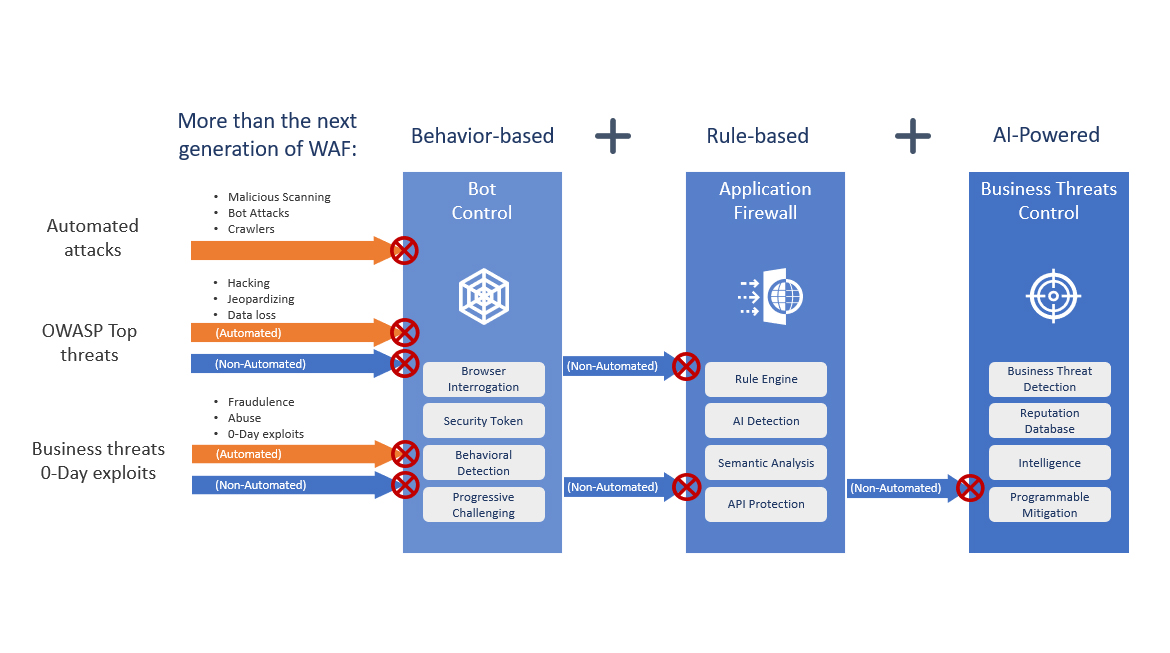Three-Layered Protection
MaxiSafe employs a three-layered protection framework designed to provide comprehensive and in-depth detection of vulnerabilities and threats. By integrating behaviour-based, rule-based, and AI-powered protection, MaxiSafe enhances its defense capabilities to effectively address various threat types, from automated attacks to sophisticated zero-day exploits.

Behaviour-Based Protection
This layer focuses on identifying automated and non-automated threats through behavioural analysis, enabling MaxiSafe to detect and respond to emerging attack patterns in real-time.
- Automated Attacks:
- Detects and mitigates high-frequency requests and bot-driven attacks through Bot Management.
- Applies rate limiting and interaction analysis to identify scraping tools and credential-stuffing bots.
- Automated and Non-Automated OWASP Top Threats:
- Monitors request payloads for signature-based threats, such as SQL Injection, Cross-Site Scripting (XSS), and Cross-Site Request Forgery (CSRF).
- Utilises AI-WAF to recognise attack patterns even in modified or obfuscated payloads.
- Automated and Non-Automated Business Threats:
- Identifies fraudulent transactions and unauthorised access attempts using Contextual Detection and IP Reputation Analysis.
- Tracks session activity to detect abnormal behaviour associated with account takeover or session hijacking.
- Automated and Non-Automated 0-Day Exploits:
- Applies heuristic analysis and anomaly detection to identify unknown attack patterns not covered by existing signatures.
Rule-Based Protection
This layer leverages predefined security rules to block specific types of non-automated threats, providing a baseline defense against well-known vulnerabilities and attack vectors.
- Non-Automated OWASP Top Threats:
- Enforces WAF rules to detect and block common attack patterns, such as command injection, XML External Entities (XXE), and Remote File Inclusion (RFI).
- Applies Content Scraping Detection to prevent unauthorized data extraction from critical endpoints.
- Non-Automated Business Threats:
- Implements Custom Rule Detection to enforce policies based on business logic, such as purchase limit validation and login frequency control.
- Monitors sensitive paths and transaction pages to prevent unauthorized access or data manipulation.
- Non-Automated 0-Day Exploits:
- Provides custom rule sets to monitor for emerging threats based on known vulnerabilities.
- Integrates Threat Intelligence Feeds to update rule sets and address newly discovered attack techniques.
AI-Powered Protection
This layer focuses on detecting complex, non-automated threats using advanced AI algorithms, enabling real-time adaptation to evolving attack tactics.
- Non-Automated Business Threats:
- Leverages Machine Learning Models to identify anomalous behaviour patterns indicative of account abuse or data exfiltration.
- Executes Behavioural Profiling to correlate session data across multiple interactions, detecting stealthy attacks that bypass rule-based protection.
- Non-Automated 0-Day Exploits:
- Applies AI-WAF to dynamically adjust protection rules based on detected anomalies.
- Conducts Payload Analysis to identify rare or suspicious request structures that deviate from normal traffic patterns.
MaxiSafe’s three-layered protection framework ensures comprehensive coverage against both common and advanced threats. By combining behaviour-based, rule-based, and AI-powered detection mechanisms, MaxiSafe creates a robust security posture capable of addressing both known and emerging attack vectors effectively.